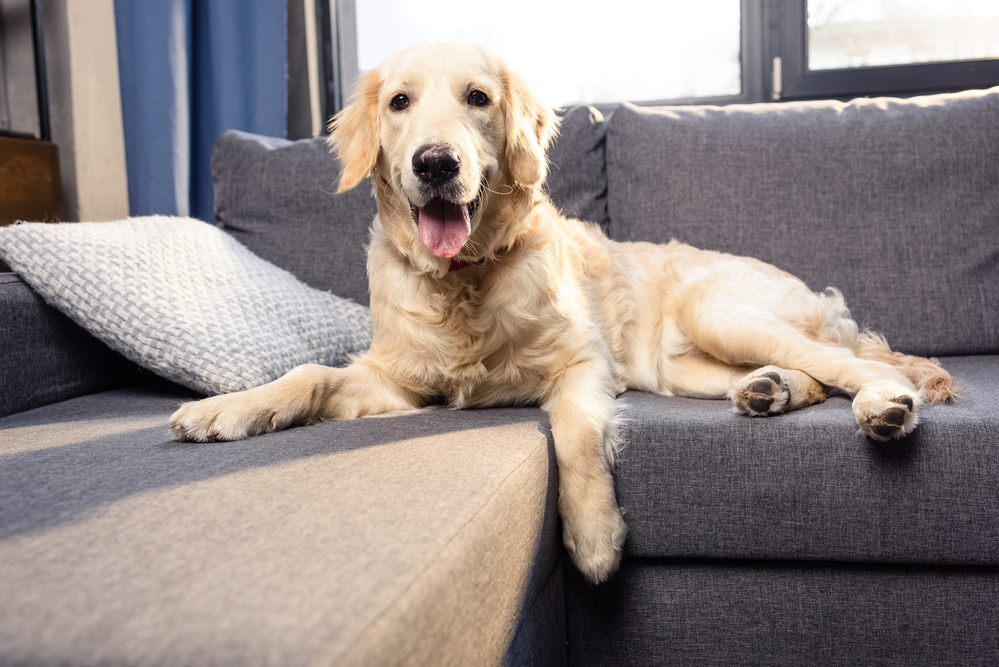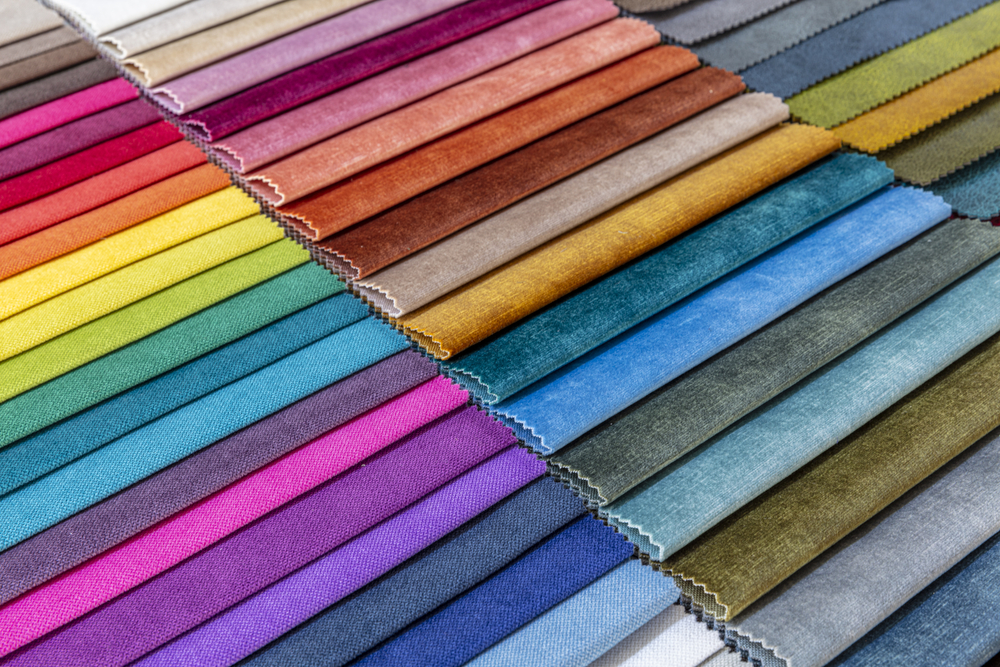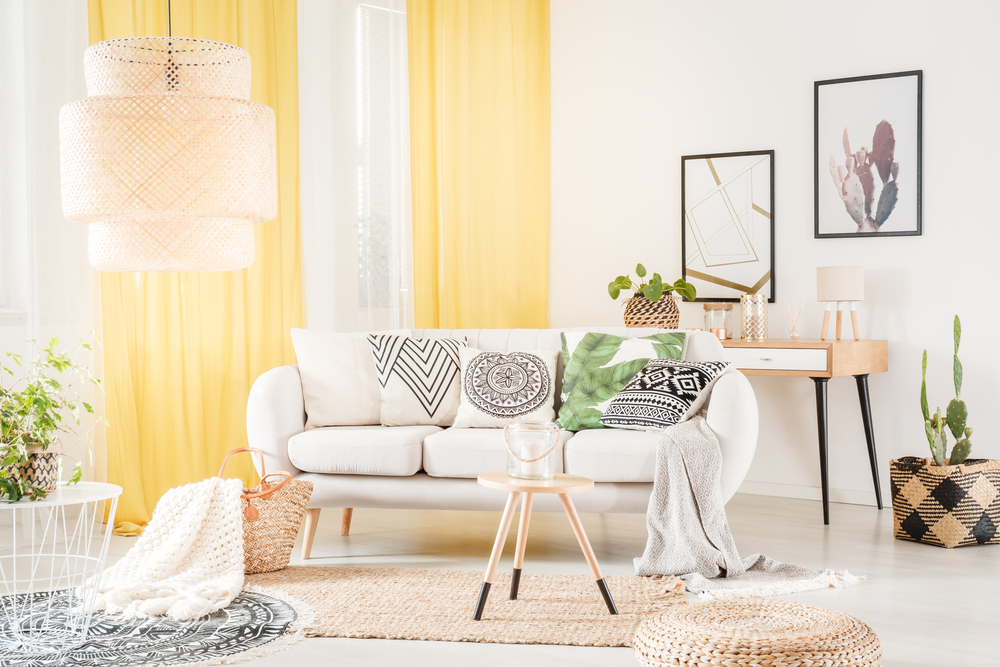
The average American family spends more than $2,000 on their living room suite, and sometimes as much as $10,000. That makes it one of the more expensive household investments you will ever make. A couch and armchairs should last for around 10 years, and perhaps as long as 15, so it’s important to choose carefully. After all, that’s a long time to be stuck with a color or style with which you’re not entirely happy.
Of course, there are numerous factors to consider that go beyond aesthetics. This is particularly the case if yours is one of the 90 million households in the USA that owns a dog or cat. The material and style of your seating need to be taken into account, as well as the way you accessorize and even its positioning in the living room.
Materials

Most people think that when it comes to living room seating, the choice comes down to leather or fabric. There is actually a little more to it than that. You might assume that leather is a bad idea when you have pets, but that’s not necessarily the case – we will look at that option in more detail in a moment. First, let’s examine the fabric options from a pet-friendly perspective, starting with the one that is often touted as the best choice for pet owners.

Microfiber
Microfiber is hard to beat if durability is your number one concern. It is highly stain resistant, as long as you clean up any accidents without delay, as the fabric is so tightly-woven. It is also color-fast, meaning the color won’t fade, even if it is situated in direct sunlight for years on end.
There are downsides to microfiber, however. One is that it looks functional rather than sophisticated, so some households feel it is more appropriate for a den or rumpus room than the main sitting room. The potential issue from a pet-owner’s perspective is that microfiber tends to attract random particles like dust – and pet hairs. That’s why it is such an effective material for cleaning cloths. Be aware that if your pet sheds a lot of hair, you could be facing an uphill battle cleaning them from microfiber upholstery.
Finally, note that microfiber is a byproduct of the petrochemical industry. We won’t go in-depth into its green credentials here, but some people feel that purchasing microfiber products is tantamount to giving support to an environmentally damaging industry.
Cotton
The most popular choice of upholstery fabric, cotton is natural, strong and can be dyed any color or pattern that you like, so it looks amazing. It is also soft and comfortable, so it doesn’t feel so much like a compromise as microfiber.
The bad news is it is nowhere near as durable. If you have a dog or cat that is simply going to snuggle down on the couch beside you, then good quality cotton upholstery with a high thread count could still serve you well. But it is not going to withstand the attacks of a rambunctious puppy or a cat that is obsessed with scratching furniture for long.
Nylon
If you are on a budget, opt for a synthetic fabric like nylon. It is hard-wearing, and will put up strong resistance to even a determined cat’s claws. Spills and stains are easy to clean, and it won’t attract and cling to pet hairs like microfiber.
So what’s the downside? Why don’t we all have nylon upholstered couches and armchairs in our living rooms? One is that it doesn’t have the same softness and comfort as natural fabric or leather, so like microfiber, it is seen as something of a compromise. Being fully synthetic, there are also concerns over its green credentials and some fear it can release toxins into the home affecting indoor air quality.
A couple to avoid
Microfiber, cotton and nylon all have their merits and their drawbacks when you are considering an appropriate fabric for pet-friendly seating. Ordinarily, we would also look at a couple of other fabrics that are popular for furniture upholstery. However, these are best avoided when you have pets.
One is linen. Hugely popular as it combines comfort with value for money, the problem from a pet-owner’s perspective is that it traps pet hairs for fun and is next to impossible to clean, unless you call in the professionals. Yes, it is quite durable, but if your cat scratches at it every day, it won’t be long before the threads start to unravel.
The other fabric to avoid like the plague is silk. It looks amazing, it feels wonderfully soft and it won’t last a week if it has dogs and cats jumping on and off it all day. This is definitely a fabric best reserved for occasional use furniture such as a loveseat or chaise lounge kept in a room that is inaccessible to the pets.
The leather question
From the jackets on our backs to the upholstery in our cars, leather is associated with high-end, expensive luxury. Intuitively, you might think it is best avoided for your living room seating if you have boisterous pets that spend time sitting on the furniture.
Don’t be too hasty ruling it out, however. Granted, a $15,000 sofa in luxury soft Italian leather is not the thing for muddy dogs or cats with a scratching fixation. But leather has been the material of choice for making hard-wearing clothes, equipment and protection for hundreds of thousands of years, since the earliest human civilizations. Are we really saying it can’t handle being sat upon by a 21st century house cat or a Cockapoo?
The real reason people tend to steer clear of leather is because it is usually more expensive than fabric, and there is the false logic that an “expensive” couch or armchair is best avoided if you have pets. As we mentioned, some extra soft luxury leathers are best ruled out, but in general, leather has a lot going for it if you have pets.
It is hard-wearing and can withstand constant traffic for years. It’s also simple to wipe clean in minutes to deal with minor accidents and to remove pet hairs. More serious cleaning and stain removal is best left to the experts, however.
Light scratches from paws and claws can generally be buffed out. With deeper ones, you have the option of either calling in a specialist or accepting that these marks and scratches are part of the natural patina that appears on leather as it ages. Some people even opt for the distressed look when buying a leather couch – go down this road and you won’t even notice the odd extra scratch!
Color choices

Choosing the type of material is by far the most important decision you will have to make. But also spend some time thinking about color. The first point to make here is that your pet doesn’t have to dictate the color scheme in your living room. If you’ve made a practical choice on the upholstery and gone with something that is easy to keep clean and hair free, then there’s no reason to shy away from that cream leather sofa if it is what you’ve been dreaming of and you think it will be a great match for the rest of your décor.
Having said that, if you’ve no major preconceptions or preferences regarding color, you can certainly make life easier by factoring your pets into your decision-making. If you have a dog that constantly sheds white hair, you might want to avoid darker shades unless you’re willing to vacuum or wipe down the sofa every day. You could also consider something with a more complex pattern using several colors, on which pet hairs will not show up so obviously.

Cushions, covers and throws
Keep in mind that for most of us, when the couch and armchairs are in our living rooms, they look quite different to when they were on display in the furniture store. We often add cushions, throws, blankets and the like, either as added protection, to make them more cozy, for decorative purposes or for a combination of these reasons.
This brings a couple of important points to the surface. The first is that if the first thing you are going to do with your living room seating is bury it under a pile of cushions, blankets and throws, the type of material you choose is less of an issue.
The second point sounds obvious but is easy to miss. Always choose machine-washable fabrics. The same applies to the cushions themselves. Even if they are in washable covers, that unmistakable aroma of wet dog can permeate through practically anything.
Ground rules and good habits
If you are able to establish a few ground rules and get into good habits with your pets, you can make life a lot easier for yourself and extend the life of your living room furniture. Cats are a law unto themselves, and while there are theories surrounding using citrus sprays and the like to deter them, you’re likely to be fighting a futile battle and the only surefire way to keep them off the furniture is to banish them from the living room. You could try creating a special space for your cat in a warm and cozy spot, but the chances are 50/50 that he will still prefer the sofa!
Dogs are another matter entirely. A puppy will learn in the space of a day or two not to get up on furniture, as long as the message is delivered consistently by all family members. For older dogs that have previously been allowed on the sofa, a sudden change to the rules is going to be more difficult to implement and could lead to frustration for both humans and canines.
Of course, some families choose to allow their dogs onto the living room furniture. If yours falls into this category, there are still good habits that you can get into with your pets – and that applies to cat owners too. Trimming nails and claws regularly will reduce the potential for damage. As with all good habits, it is one easiest instilled from a young age. If introduced to the concept as kittens and puppies, pets will accept having their claws trimmed as a routine part of life.
Owners can do it themselves using normal nail clippers, but only do so if you know what you are doing. Trim the claws correctly and your pet won’t feel a thing, it’s no different to trimming your fingernails. However, if you clip the quick of the nail, it will cause pain and destroy trust. If you are in the slightest doubt, entrust the task to a qualified expert. It only takes a couple of minutes and will not be expensive.
Think about the layout
Assuming your pet is as welcome on the furniture as any other member of the family, there are a few precautions you can take when it comes to layout that will help avoid incidents and accidents. If your seats are close to walls, ensure any pictures or hangings are a reasonable distance away, staying clear of the awesome destructive power of a dog’s tail or the insatiable curiosity of a cat.
From a cat’s perspective in particular, a furnished living room is nothing more or less than an adventure playground. Think about what is within leaping distance, and if you want to protect your precious ornaments or your tropical fish, don’t let your new living room seating provide easy access.
In conclusion
There are no hard and fast rules about which materials to choose for pet friendly seating. However, leather and man-made fabrics are generally the most hard-wearing and the easiest to keep clean. With other natural fabrics, you can save yourself hard work and heartache by adding blankets, throws and cushions for extra protection.
Regardless of the type of seating you choose, if you invest a little time and effort into training and instilling good habits in your pet, it will pay dividends further down the line.






